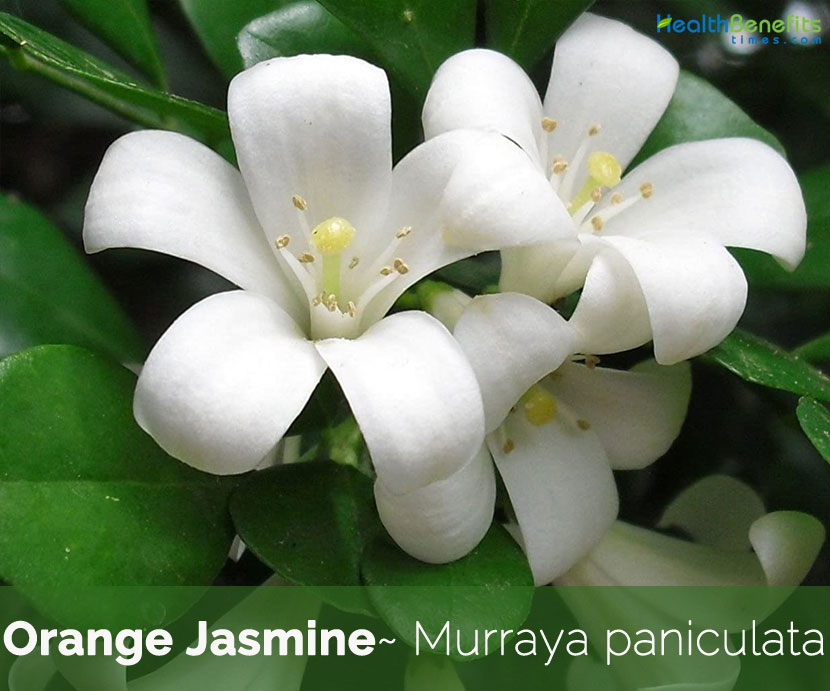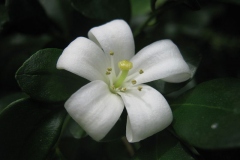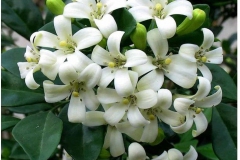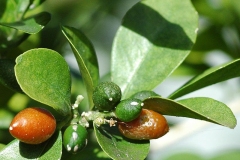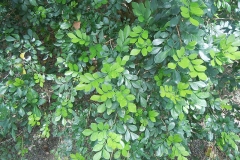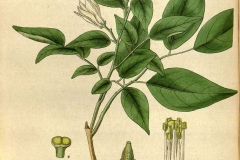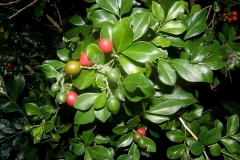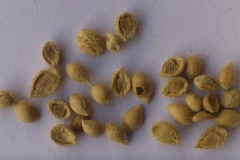| Orange Jasmine Quick Facts | |
|---|---|
| Name: | Orange Jasmine |
| Scientific Name: | Murraya paniculata |
| Origin | Southern China, Taiwan, the Indian sub-continent, south-eastern Asia and northern Australia |
| Colors | Green turning to orange or bright red in color as they mature |
| Shapes | small fleshy, egg-shaped or oval berries about 12 mm long and 5 – 14 mm in diameter |
| Taste | Sweet |
| Health benefits | Overcome pain due to ulcers, Treat Boils, Treat Arthritic Joints, Treat Toothache, Can Slim Body, cure Inflammation of the Testicles, treats Urinary Tract Infections, smooth menstruation, Smooth Skin |
| Name | Orange Jasmine |
|---|---|
| Scientific Name | Murraya paniculata |
| Native | Southern China, Taiwan, the Indian sub-continent (i.e. India, Nepal, north-eastern Pakistan and Sri Lanka), south-eastern Asia (i.e. Cambodia, Laos, Myanmar, Thailand, Vietnam, Indonesia, Malaysia and the Philippines) and northern Australia (i.e. the northern parts of the Northern Territory, far northern Queensland and northern Western Australia) |
| Common Names | Common jasmine-orange, Orange-jasmine, Hawaiian mock-orange, Chinese box, Jasmine-orange, Mock orange, Burmese-boxwood, China-box, Chinese-boxwood, barktree, cosmetic bark tree, orange jessamine, satinwood, Chinese-myrtle, Jessamine, Lakeview jasmine, Honey bush, Murraya, mock lime |
| Name in Other Languages | Afrikaans: Lemoenjasmyn Arabic: Muraya euthkulia (مورايا عثكولية) Assamese: Kamini (কামিনী, Kamini-kanchan Bengali: Kamini (কামিনী) Burmese: Yujan pain (ယုဇနပင်) Chinese: Jiu li xiang, Qian li xiang, Yue ju, Shi gui shu, Kau lei heung English: Common jasmine-orange, Orange-jasmine, Hawaiian mock-orange, Chinese box, Jasmine-orange, Mock orange, Burmese-boxwood, China-box, Chinese-boxwood, barktree, cosmetic bark tree, orange jessamine, satinwood, Chinese-myrtle, orange-jessamine, satinwood, Jessamine, Lakeview jasmine, Honey bush, Murraya, cosmetic bark Finnish: Tuoksujasmikki French: Orange-jessamine, bois buis, bois de Chine, bois jasmin, Rameau, buis de Chine German: Orangenraute, Jasmin-Orangenraute Gujarati: Jāsavantī (જાસવંતી) Jaswanti, Kamini (કામીની) Hindi: Gacharisha, Madhukamini (मधुकामिनी), Kamini (कामिनी), Mar Chula, kaaminee,kamini marchula, Pandari, Nagagolunga, konji, Angarankana gida, Bian malika Hungarian: Narancsjázmin Indonesian: Kemoening, Djenar Irula: Shettithymaram Japanese: Gekkitsu (ゲッキツ) Inutsuge, Kuribana, Gigicha, Gigichi, shiruku-jasumin (シルクジャスミン), Gekkirsu, Inutsuge, kuribana Javanese: Kemuning Kannada: Angara kina, Murrāya pyānikyulēṭa (ಮುರ್ರಯ ಪ್ಯಾನಿಕ್ಯುಲೇಟ), Kadu karibevu (ಕಾಡು ಕರಿಬೇವು) Laos: Keo Malay: Pokok Kemuning Malaysia: Kemuning, Kemuning putih Malayalam: Kattukariveppu, Maramulla, Kaattu Kariveepp (കാട്ടു കറിവേപ്പ്),Kattukariveppu, Maramulla (മരമുല്ല) Manipuri: Kamini kusum (কামিনী কুসুম) Maori (Cook Islands): Tiare ‘ānani Marathi: Kunti (कुन्ती), Pandhari (पांढरी) Mizo: Mungti Myanmar: Yuzana Nepali: Kaamimi Phool (कामिनी फूल), Simaali (सिमाली), Bajaradante (बजरदन्ते) Oriya: କାମିନୀ Persian: پرتقال یاسمنی Philippines: Banasi Portuguese: Murta de cheiro or jasmim laranja Russian: Murrayya metel’chataya (Муррайя метельчатая) Sinhalese: Aetteriya, Etteriya Spanish: Naranjo jazmín, flor de ramo, chalcas, mirto Sundanese: Kamuning Swedish: Doftruta Tagalog: Kamuning Tahitian: Tiare ‘ānani Tamil: Cimaikkonci, Kattu karuveppilai, Konci, Muṟaiyā pōṉikkulēṭṭā (முறையா போனிக்குலேட்டா) , Vengarai (வெங்காரை), Katar-konci (கடற்கொஞ்சி), Karu-veppilai (கருவேப்பிலை), Kattu-karuveppilai,Marchula,Malailakkadi -Hi,Kamini, Konci (கொஞ்சி) Telugu: Nagagolungu , Naga-golanga (నాగగొలంగ) Thai: Kaeo (แก้ว) Tonga: Olive Vietnamese: Nguyệt quới Visayan: Kamuning, Banati |
| Plant Growth Habit | Small, slow-growing, tropical, evergreen tree or bushy shrub |
| Growing Climates | Closed forests, open woodlands, watercourses (i.e. riparian areas), native bushland, forest margins, pastures, disturbed sites, waste areas, gardens and roadsides in the wetter tropical and sub-tropical regions |
| Soil | Grows best in well-drained, nematode-free soil with moderate moisture and is well-suited for use as a tall informal screen |
| Plant Size | 2-4 m tall and 60 cm in diameter, but occasionally reaching up to 7 m in height |
| Bark | Smooth, pale to whitish |
| Young Shoot | Glabrous to puberulous or distinctly hairy |
| Stem | Hairy |
| Leaf | Glabrous and glossy, occurring in 3-7 oddly pinnate leaflets which are elliptic to cuneate-obovate to rhombic with a smooth or notched edge with a length of up to 5 cm. When grated, the leaves develop a citrus-like smell |
| Flowering season | June–March |
| Flower | Terminal, corymbose, few-flowered, dense and fragrant. Petals are 12–18 mm long, recurved and white (or fading cream). The pleasantly fragrant flowers are five-fold with a double flower envelope. The five sepals are ovate to lanceolate with a length of up to 2 mm |
| Fruit Shape & Size | Small fleshy, egg-shaped or oval berries about 12 mm long and 5 – 14 mm in diameter often apically pointed, glabrous |
| Fruit Color | Green to orange or bright red in color as they mature |
| Propagation | Sexually propagated by its seeds and Asexually propagated by softwood cuttings |
| Plant Parts Used | Leaves, twigs, roots, skins and stems |
| Seed | One or two dull, yellowish-grey or greenish, teardrop-shaped seeds |
| Taste | Sweet |
| Season | January–August |
| Health Benefits |
|
Plant Description
Orange Jasmine is a small, slow-growing, tropical, evergreen tree or bushy shrub that normally grows 2-4 m tall and 60 cm in diameter, but occasionally reaching up to 7 m in height. The plant is found growing in closed forests, open woodlands, watercourses (i.e. riparian areas), native bush land, forest margins, pastures, disturbed sites, waste areas, gardens and roadsides in the wetter tropical and sub-tropical regions. The plant grows best in well-drained, nematode-free soil with moderate moisture and is well-suited for use as a tall informal screen. It can be pruned and also grown as garden hedge! Young shoots are glabrous to puberulous or distinctly hairy.
Stems
Younger stems are green and hairless (i.e. glabrous) or covered in tiny hairs (i.e. minutely pubescent). Older stems become woody and brown or grey in color. They can reach up to 13 cm across and may eventually become fissured and rough. Bark is smooth and pale to whitish colored.
Leaves
Leaves are alternately arranged along the stems and borne on stalks (i.e. petioles). These leaves are 6-11.5 cm long and are once-compound (i.e. pinnate) with 3-9 leaflets. The glossy leaflets are 1.5-7 cm long and 1.2-3 cm wide and are narrowly oval (i.e. narrow-elliptic) to somewhat egg-shaped in outline (i.e. ovate or obovate). They have entire margins, wedge-shaped (i.e. cuneate) bases, and pointed tips (i.e. acuminate apices).
| Leaf arrangement | Alternate |
| Leaf type | Odd-pinnately compound |
| Leaf margin | Entire |
| Leaf shape | Obovate |
| Leaf venation | Pinnate |
| Leaf type and persistence | Evergreen |
| Leaf blade length | Less than 2 inches |
| Leaf color | Green |
| Fall color | No fall color change |
| Fall characteristic | Not showy |
Flowers
The fragrant flowers are borne in clusters, containing up to eight flowers, at the tips of the branches or in the upper leaf forks (i.e. terminal or upper axillary cymes). Each flower has five green sepals and five white petals that are 10-18 mm long that are curved backwards (i.e. recurved). They also have ten stamens and an ovary topped with a style and a globular (i.e. capitate) stigma. Flowering occurs irregularly throughout the year, often in response to rain, but is most common from late winter through to late spring.
| Flower color | White |
| Flower characteristic | pleasant fragrance; year-round flowering |
Fruit
The fruit is an egg-shaped (i.e. ovoid) to oval (i.e. ellipsoid) berry about 12 mm long and 5 – 14 mm in diameter. Fruits are initially green turning to orange or bright red in color as they mature and contain one or two dull, yellowish-grey or greenish, teardrop-shaped seeds.
| Fruit shape | Oval |
| Fruit length | 0.5 to 1 inch |
| Fruit cover | Fleshy |
| Fruit color | Red |
| Fruit characteristic | Persists on the plant |
Health benefits of Orange jasmine
Orange jasmine (Murraya paniculata L.) usually grows wild on the edge of the forest, in the undergrowth, and guardrail garden and planted as an ornamental plant in the yard. Such as ylang and jasmine flowers, yellow flowers are also often used for traditional medicine. Parts of plants that can be used are the leaves, twigs and roots. Skins and stems are also useful for medicine. Listed below are some of the popular health benefits of orange jasmine
1. Can Smooth Skin
Yellow leaves are still fresh as much as 30 g washed and then pounded until creamed. Add 1 cup of water was while in the mix with the average. The material is then scrub on the skin before bedtime.
2. Treat Toothache
Slice the yellow flowers to get the oil. Then heat the flower’s natural oil over the fire for a few moments, using a small flame as it heats. Then, drip the oil on a tooth that has holes and swollen gums.
3.Treat Boils
Dried yellow root that is as much as 30 g washed and cut into pieces as needed. Boil 3 cups of water until the water boiled only the remaining l glasses. Once cool filtered the drink. Take 2 times a day, each ½ cup.
4. Can Slim Body
Yellow leaves and the leaves of noni and handful of Intersection drops too much as half a little finger until finely ground. Add 1 cup cooking water, stirring until evenly distributed. Squeeze with a piece of cloth. Water that is collected is drunk in the morning before eating.
5. Inflammation of the Testicles
Provide 9 pieces of yellow leaves as much as 60 g and 35 g of bitter herbs. Wash and then boil in 3 cups water until the remaining 1 cup water. Once everything is cold filtered, and then taken 2 times a day, each ½ cup. Do it every day until cured.
6. Smooth menstruation
Yellow leaves and leaves of henna each fresh ingredient as many handheld ½, 1 finger rhizome of ginger leaves, washed and cut into pieces as needed. Add 3 cups water was then boiled until the remaining 1 cup water. After the cold filtered water, then drink 2 times a day, each ½ cup.
7. Treat Arthritic Joints
Orange Jasmine root and Lantana camara root is washed, then add 3 pairs of chicken legs. And all the ingredients are cut into pieces as needed and then add enough water to be submerged. All the ingredients are then cooked. Once cooked and the water is drunk warm.
8.Treating Urinary Tract Infections
Take the leaves of yellow flowers, wash and then boil with 3 cups water as much as 3 grams, then let the water boil down to shrink the half. Then afterwards, wait for the water to cool, then strain and drink the water 3x a day, in the morning ½ cup, afternoon ½ cup, and the night ½ cup. It can eventually cure your Urinary tract infection.
9. Overcome pain due to ulcers
Take 30 grams of dried yellow root then wash with running water and cut into pieces. Then boiled with 3 cups water, until the water shrink 2 cups. After the water becomes cold, strain and drink the water 2 times a day, namely: morning and evening, each ½ cup.
https://www.youtube.com/watch?v=2DrLjtnQauI
Traditional uses and benefits of Orange Jasmine
- Orange Jasmine is used both in traditional medicine as an analgesic and for wood (for tool handles).
- Decoction of the leaves is taken to treat bruises, chronic dysentery, stomach ache, swellings and skin irritations in Chinese medicine.
- It is also used to relieve pain.
- Leaves are also used in other countries as a tonic, to cure toothache and herpes and to expel tapeworms in Malaysia.
- It is used as a stimulant in Indonesia.
- It is used to increase the menstrual flow and to treat diarrhea and dysentery in the Philippines.
- It is used for fever and dysentery in Indochina.
- Fruits and barks are sometimes also used medicinally.
- Leaf and bark decoction are taken to treat malaria, diabetes, dysentery and fractured bones in Nigeria.
- Leaf infusion is taken to treat diabetes in Mauritius.
- Maceration of leaves in alcohol is applied to treat muscle-ache.
- Leaves, fruits and bark are used medicinally against fever, venereal diseases, intestinal worms and dysentery in Asia.
- Leaves are also described as an ingredient in an infusion against irregular menstruation and leucorrhoea, and to promote delivery.
- Leaves and twigs are useful in overcoming inflammation of the testicles (orchitis), could also overcome inflammation of the airways (bronchitis), urinary tract infections, gonorrhea, vaginal discharge, and come irregular menstruation, body fat overload, and slimming the body, pain ulcer (ulcer), dental pain and soften the skin.
- Its roots are also useful for treating bruises caused by collision or hit, rheumatic pain, sprains and insect bites and poisonous snakes, boils, eczema and scabies.
- Bark is also useful to overcome tooth pain, pain due to open sores in the skin or mucous membranes (ulcers).
- Poultice of fresh leaves are used for swelling due to sprain and contusions, poisonous snake bites.
- Infusion of the leaves is used as tonic also for diarrhea and dysentery.
- Decoction of leaves is used as mouthwash for toothache.
- Leaves and root bark is used for rheumatism, cough and hysteria.
- It is also used for abscesses, cellulitis, tapeworm diseases, rheumatic fever, coughs, giddiness, hysteria, and thirst and burning of the skin.
- Infusion is used for herpes of the stomach and the sediments applied externally.
- In Malaysia it is used to treat dysentery and morning sickness.
- In Yi medicine in China it is used for common colds, fever, cough, sore throat and influenza.
- In Gujarat region of India, it is used to regulate fertility.
- In Singapore, leaves are ingredients of a tonic given for irregularities in the regenerative organs of young women.
- In China plant is widely used for stomach ache, toothache, rheumatism, paralysis and diabetes.
- In Nepal it is used for the treatment of abdominal pain, diarrhea, stomach ache, headache, swelling, and thrombosis and blood stasis.
- Stems of the plant are also used for toothache and oral care in India, where traditional practitioners advise brushing teeth with stems to get relief from toothache and for maintaining healthy gums and teeth
Culinary Uses
- In Malaysia, it is widely used as food flavor additive for cuisine, in preparing meat, fish and Soup.
- Flowers are used for scenting tea.
- Leaves are used to flavor curries.
Other Facts
- Wood is very hard and is used for construction works and agricultural implements.
- The aromatic flowers are used for scenting tea or in the production of cosmetics.
- From the wood tool handles, walking sticks and furniture is made.
- Ripe fruits are eaten raw and have a sweet taste.
- It is commonly planted in the Indian Ocean Islands as an ornamental shrub, or as a hedge.
- In Asia it is also grown as a living fence.
- Top branches with leaves are used for making wreaths and in giving body to bouquets.
- In Thailand and Burma powdered bark and root is used as cosmetic.
- Flowers are occasionally put in the hair for their pleasant smell.
- In Java flowers are used in making Cosmetics.
- Essential oil is used in perfumery.
- Sweet scented “Thanaka powder” made from wood and roots are used as cosmetic on women’s Cheeks.
- The wood, even from smaller trees, is used locally to make tool handles, walking sticks, and furniture or used for turning.
References:
https://www.itis.gov/servlet/SingleRpt/SingleRpt?search_topic=TSN&search_value=825225#null
http://www.hear.org/pier/species/murraya_paniculata.htm\
https://npgsweb.ars-grin.gov/gringlobal/taxonomydetail.aspx?id=24704
http://www.missouribotanicalgarden.org/PlantFinder/PlantFinderDetails.aspx?taxonid=286748
https://www.cabi.org/isc/datasheet/35178
https://inpn.mnhn.fr/espece/cd_nom/447581?lg=en
https://profiles.ala.org.au/opus/foa/profile/Murraya+paniculata
http://www.theplantlist.org/tpl/record/kew-2510469
https://en.wikipedia.org/wiki/Murraya_paniculata
http://www.flowersofindia.net/catalog/slides/Kamini.html
https://keyserver.lucidcentral.org/weeds/data/media/Html/murraya_paniculata.htm
https://indiabiodiversity.org/species/show/31589
https://www.nparks.gov.sg/florafaunaweb/flora/2/2/2239
https://uses.plantnet-project.org/en/Murraya_paniculata_(PROTA)
http://www.tropicaltimber.info/specie/kemuning-murraya-paniculata/#lower-content
https://gd.eppo.int/taxon/MUYPA


